Germany was a leader in self propelled artillery at the start of WWII. Approaching the idea of motorized artillery from a new angle, they ended up with a wide spectrum of SPGs by the middle of the war. This also applied to self propelled howitzers, which were first used in France in 1940. Truly mass produced SPHes entered service closer to mid-1943. These were the Grille (Grasshopper), the best SPG series with the 149 mm sIG 33 howitzer.
Best chassis for a big gun
The idea to install the heavy 149 mm sIG 33 howitzer on a self propelled chassis was implemented in early 1940. Alkett designed the 15 cm sIG 33 (mot S) auf Pz.Kpfw.I Ausf.B on the chassis of the Pz.Kpfw.I Ausf.B. The conversion was fast to develop, but not particularly good. The resulting vehicle was too tall and too heavy, so the cannon was often unloaded and towed behind the vehicle during travel.
Understanding that the Pz.Kpfw.I chassis is ill-suited for such a big and heavy gun, Alkett began working on an analogous vehicle using the Pz.Kpfw.II Ausf.C chassis. This time the wheels were removed, which reduced the height of the SPG. However, trials showed that it was too cramped inside and that the Pz.Kpfw.II chassis could not be used in its initial form. This led to the 15 cm sIG 33 B Sfl, a lengthened Pz.Kpfw.II chassis with a new engine. This resulted in a roomier fighting compartment. However, the 15 cm sIG 33 B Sfl was not particularly successful. The vehicle carried only 10 rounds of ammunition. The mass of 16 tons and a power to weight ratio of under 10 hp/ton resulted in not only low performance, but low reliability. It is not surprising that the 15 cm sIG 33 B Sfl was produced in even smaller numbers than its predecessor. Only 20 units were built.
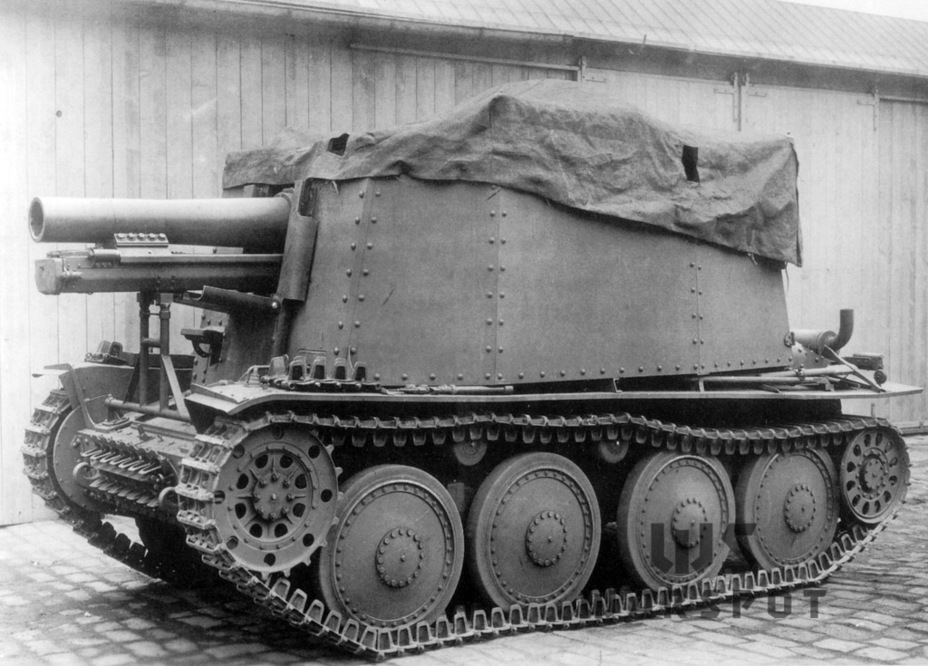
German command could see that their own light tanks did not make good chassis for SPGs even before the 15 cm sIG 33 B Sfl was developed. In addition to significant issues with mobility and ammunition capacity they had an even more glaring weakness. The established idea for assault SPGs was direct fire at enemy fortifications, usually at point blank range. Considering that the Pz.Kpfw.I and Pz.Kpfw.II had bulletproof armour this was a very bold maneuver. Thicker armour was needed. This kind of vehicle was ordered at Skoda, which was under SS control at the time.
Skoda still had hope of pushing through its own tanks and SPGs into the German army. An assault SPG was developed based on its T-23 tank (the earlier T-21 is also mentioned). It was named Voss II after the general director of the company Wilhelm Voss (honorary SS Standartenfuhrer). The Voss II was similar to Alkett's design in concept: the turret platform and turret were removed and a sIG 33 carriage without wheels was installed instead in an open topped casemate.
According to the requirements, the mass of this SPG would be 16 tons, but based on the design of the Voss I it was going to be closer to 18. Since the T-23 chassis was wider, the fighting compartment was bigger than Alkett's design. Another advantage of the Voss II was the stronger front armour (it reached 50 mm in thickness). The vehicle was also more mobile. The biggest drawback was the T-23 chassis. The interest in the T-23 from the German side began to wane in 1941, and so there was no interest in the model of the Voss II built in 1942.
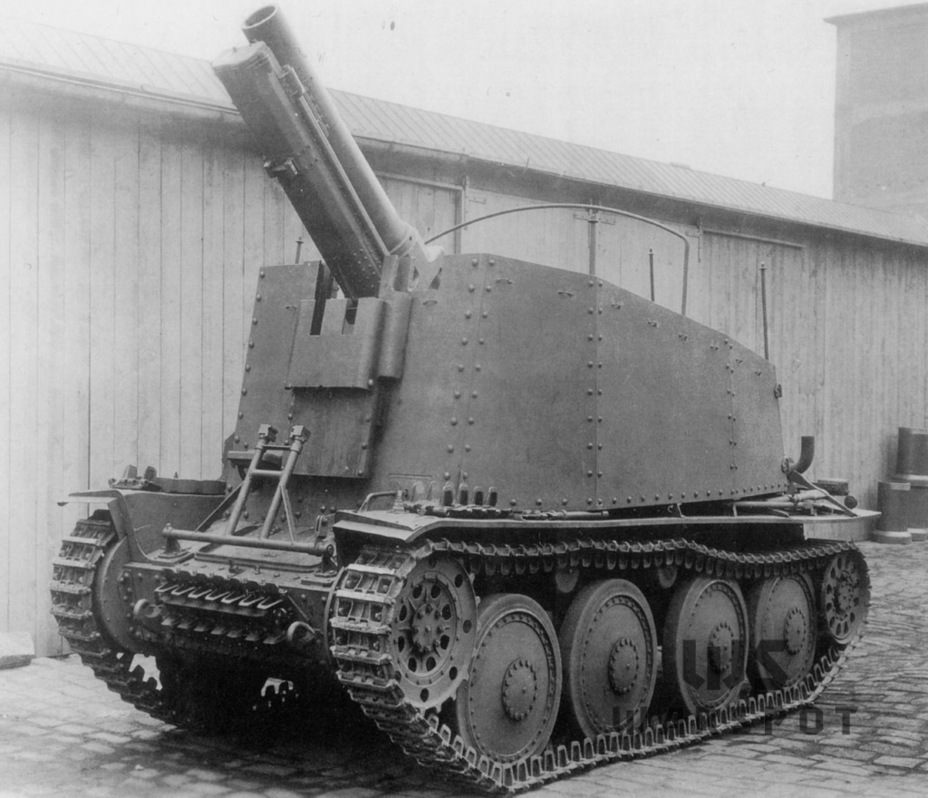
The Voss II later evolved into the StuIG 33 and Sturmpanzer vehicles, and Skoda was involved in both projects. The problem was that the Germans still needed light assault guns. Despite all of the drawbacks of existing designs, artillery batteries with these vehicles performed well. Because of this Alkett once again found itself involved with the creation of an assault SPG in mid-1942. By this point it was clear that the era of light tanks on the battlefield was over, and the trend shifted towards developing SPGs on their chassis. The Pz.Kpfw.38(t) was among these obsolete tanks.
Production of tanks of this type ended in June of 1942. The chassis was used for Pz.Sfl.2 für 7,62 cm Pak 36 for three months by that point. The vehicle was developed by Alkett, a part of the Rheinmetall-Borsig conglomerate. Designers from Alkett borrowed a lot of concepts from the Pz.Sfl.2 für 7,62 cm Pak 36 for their new vehicle, namely maximal use of the base chassis with as few alterations as possible. This allowed them to reuse existing chassis already produced at BMM.
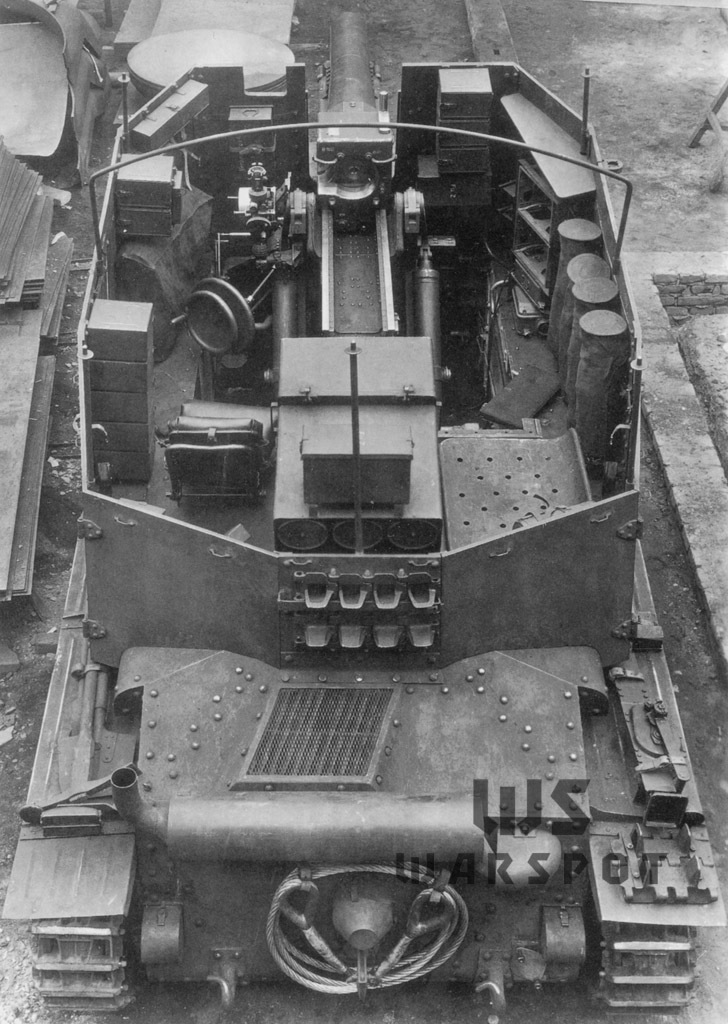
The first experimental SPG was ready towards the end of 1942. The changes to the chassis were minimal. The biggest change had to be made to the front plate, left over from the turret platform. Unlike the tank destroyer, there was no hull gunner in the SPG. His observation device and machine gun were also removed. The driver's station was also changed. Unlike the Pz.Sfl.2 für 7,62 cm Pak 36 which had armour covering the gun crew from the front and only partially from the sides, the new vehicle had a proper casemate. This had its advantages and drawbacks. On one hand, the height of the vehicle grew to 2.4 meters, which made it a tempting target. The front armour was only 25 mm thick and the sides only 15 mm thick, enough to protect from rifle caliber bullets. On the other hand, Marder II and Marder III vehicles weren't any lower. The full sized casemate was also there for a good reason: the ammunition and radio were placed on the inside. There was no other way to carry a sufficient amount of ammunition.
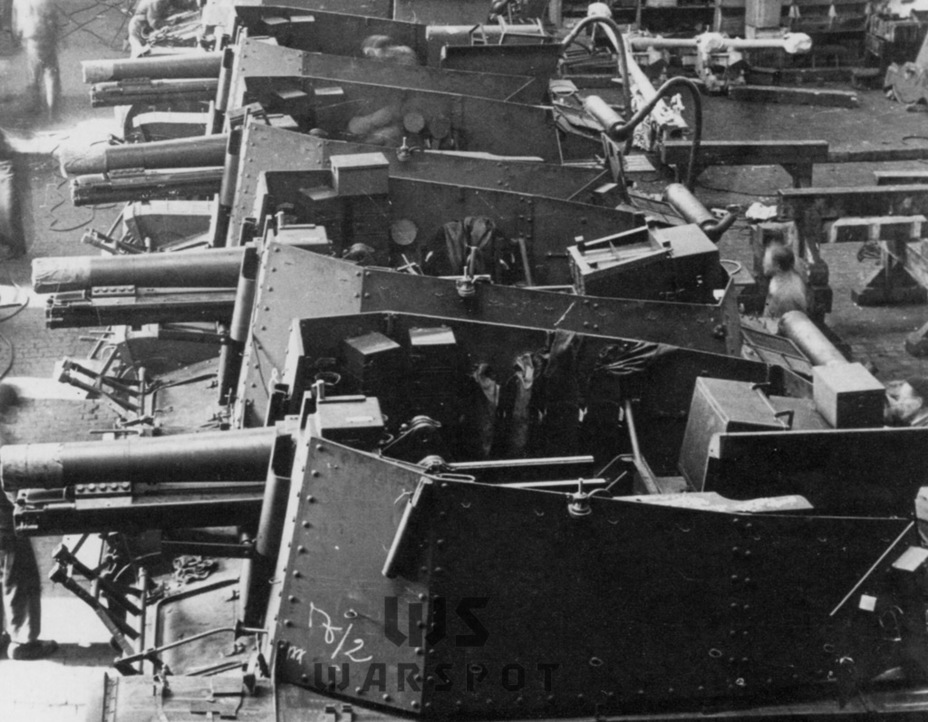
Rheinmetall converted the gun especially for the new SPG, which was named Geschützwagen 38 für sIG 33/1 (Sf.). The oscillating section of the new gun, named 15 cm sIG 33/I, was unchanged. The carriage was altered to take up as little room as possible in the fighting compartment. As a result, the casemate could fit a commander, gunner, loader, an breech operator, although not in the most comfortable positions. Only the driver and gunner had real seats, the loader and commander (on the prototype he was located to the right, behind the driver) perched on a small bench and the breech operator had to settle for a small stool.
Despite the small dimensions, Alkett designers managed to fit 15 rounds of ammunition inside the vehicle, an achievement indeed considering the large caliber. To compare, the much larger Hummel only carried 18 rounds. The bore axis height did not grow by much compared to the much lower Pz.Sfl.2 für 7,62 cm Pak 36, from 1500 mm to 1830. The most important thing was the mass: the Geschützwagen 38 für sIG 33/1 (Sf.) weighed only 11.5 tons, less than 2 tons more than the initial Pz.Kpfw.38(t). The vehicle received the more powerful 150 hp Praga AC engine, which increased the power to weight ratio.
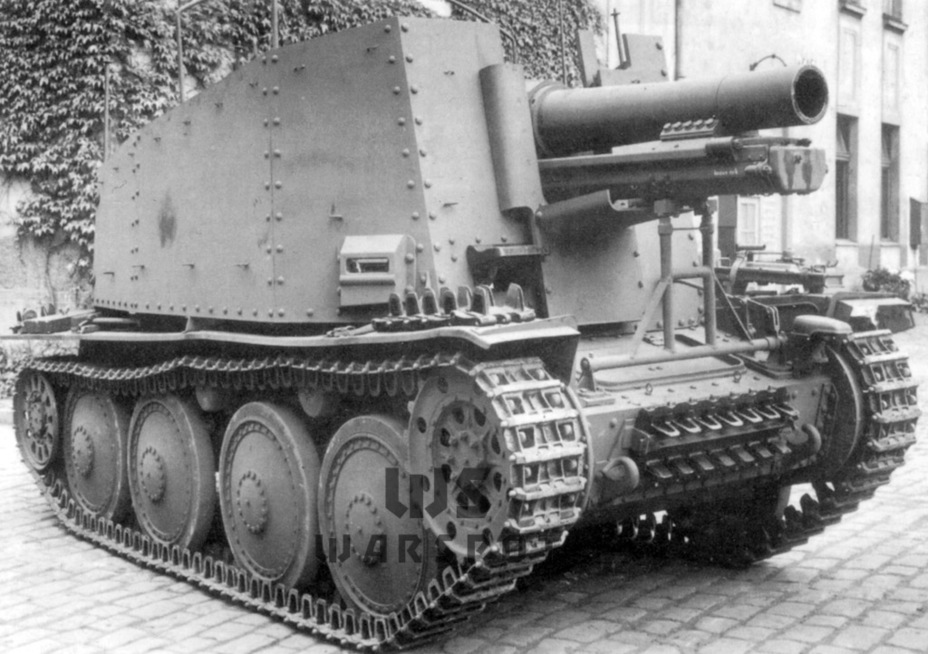
As a result of trials the Geschützwagen 38 für sIG 33/1 (Sf.) changed a little. The gun shield on the original moved up and down on skids, on the production vehicle it flipped forward. The most important change was relocation of the crew members. The commander moved to where the loader was and received a proper seat. The radio and antenna port moved to the rear left of the casemate. The location of the ammunition also changed. These changes were not that important, the biggest achievement was the creation of a light SPG with an acceptable onboard ammunition capacity.
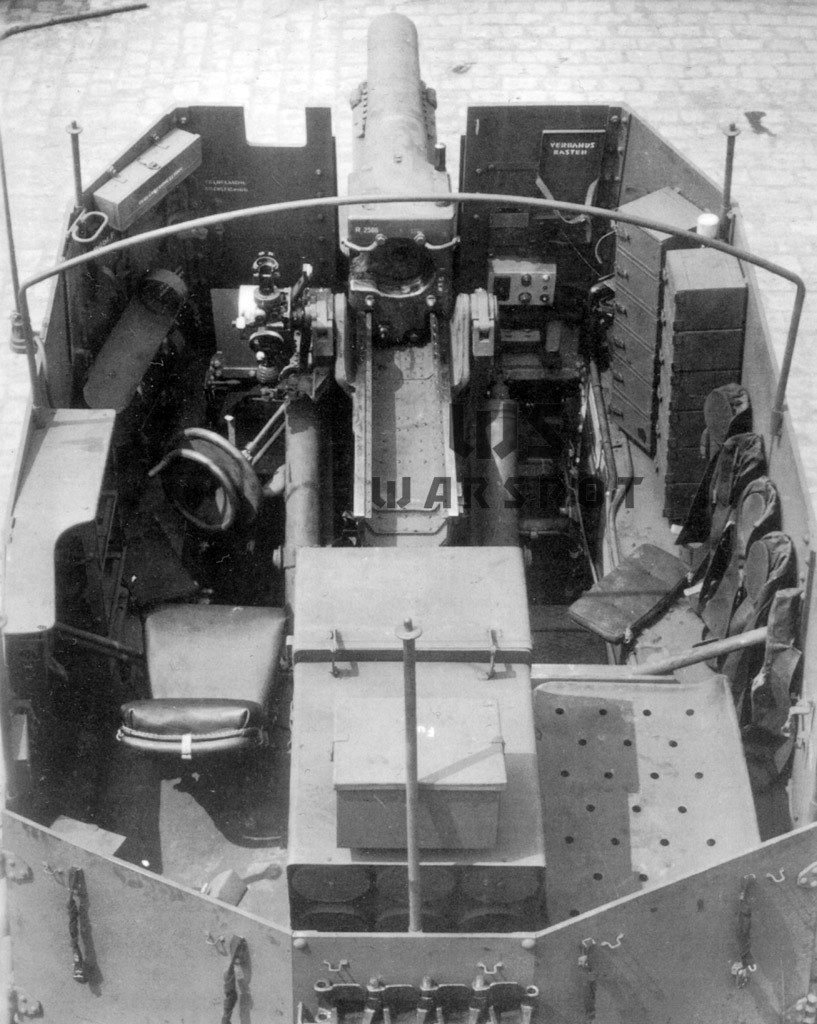
Like with the Pz.Sfl.2 für 7,62 cm Pak 36, Alkett only designed the vehicle. The factory was already overloaded with other work and no one expected to add the SPG on a Czech chassis to the mix. The contract for 200 vehicles went to BMM. Since existing chassis were converted, production went quickly, although the factory was about a month behind quota. The first 25 SPGs were finished in February of 1943, 40 in March, 52 in April, 52 in May, 31 in June. 10 more were built in October of 1943. By then the SPG was named Grille (Grasshopper).
Unlike the name Marder III, which was used very rarely, the name Grille comes up in correspondence often. For instance, a report on distribution of new vehicles written by Guderian on May 4th, 1943, mentions both this name as well as Wespe and Hornisse, but not Marder. The name «Grille Ausf.H» sometimes comes up in books, but it has no connection with reality. Like tanks, Grille SPGs received serial numbers. Since various chassis were used to build the Grille the range of numbers was very large, from 1950 to 2637.
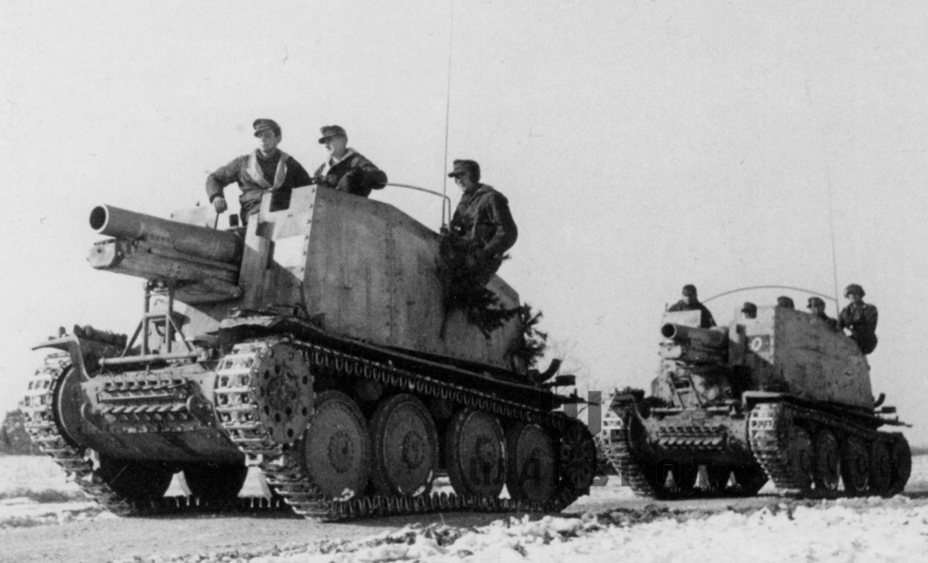
The first Grille left BMM in March of 1943. Heavy howitzer batteries (TO&E K.St.N 11206a) were formed specifically for them. According to the TO&E, a battery contained two platoons of two Grille each. The SPGs began to arrive in their units in April of 1943. Like its predecessors, the Grille was first sent to tank units, as a rule two batteries were assigned to each division (the 1st, 16th, 24th, and 26th). Panzergrenadier divisions began receiving these SPGs in May of 1943. The 3rd and 29th Panzergrenadier Divisions were the first (12 each), Feldherrnhalle got one battery, but Grossdeutschland received most of all, a whopping 16 Grille. These vehicles were also used by the SS: Leibstandarte, Das Reich, and Totenkopf each got 12. Supplies to tank divisions continued: the 17th, 4th, 2nd, 5th, and Hermann Goering divisions received two batteries apiece. Later, in early December of 1943, the 4th Tank Division got 6 more Grille. The last vehicles of this series ended up at the 1st Ski Brigade.
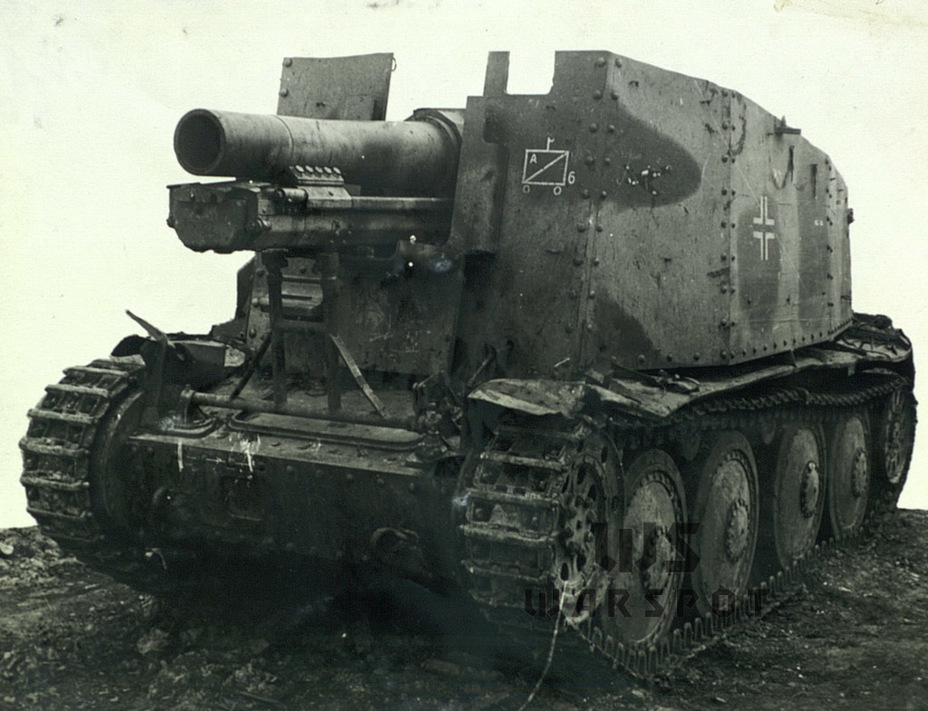
Like the Wespe, Hornisse/Nashorn, and Hummel, the Grille debuted in Operation Citadel. These vehicles were already in use by the 2nd, 4th, and 5th Tank Divisions, Grossdeutschland Panzergrenadier Division, and Leibstandarte, Das Reich, and Totenkopf divisions. The concept of using these SPGs changed somewhat by that point. They were used for indirect fire rather than as assault guns. Because of this the Grille suffered few losses at first. The 4th Tank Division lost 6 vehicles of this type, more than anyone else. The 1st and 5th divisions lost one apiece during the summer, Grossdeutschland lost two. Low losses allowed for rapid replacement from reserves. Interestingly enough, the losses in Italy were on par with those on the Eastern Front. During the Battle for Salerno the 16th Tank Division lost 3 Grille, and the 26th Tank Division lost just one. Earlier, in July-August of 1943, the 29th Panzergrenadier Division lost 2 Grille in Sicily. It also lost vehicles of this type at Salerno. The losses were partially due to Italy's mountainous terrain.
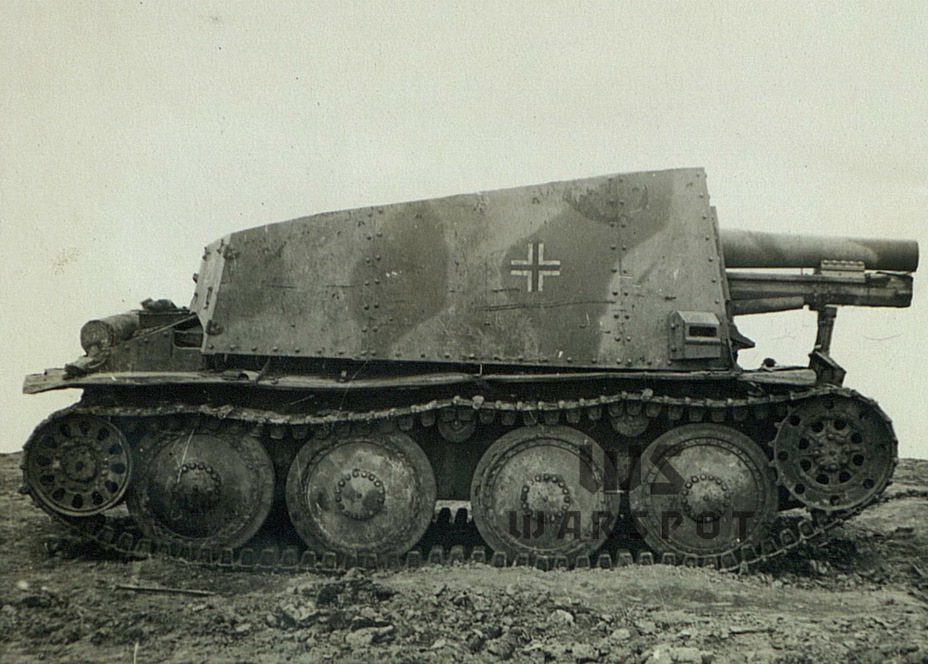
These low losses put the Grille among the most resilient German SPGs. As of March 15th, 1945, Germany had 137 Grille on hand out of 389 produced, a third of the total number. These SPGs were actively used on the Soviet-German front, in Italy, and in Normandy. Their survivability is hardly their most important statistic. The armament was somewhere between the Wespe and Hummel in power, which is not meant as a compliment. The 15 cm sIG 33 was designed to fire directly or from small distances, meaning that the Grille had to drive dangerously close to the enemy. In addition, even the increased ammunition capacity was not enough.
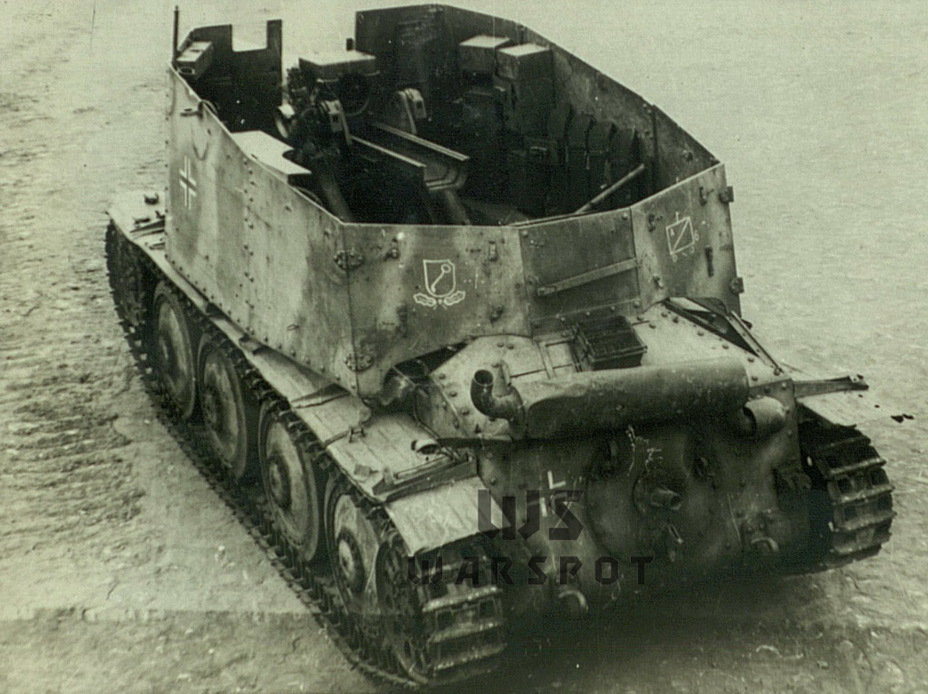
The Wespe was close to the Grille in terms of effective range and purpose on the battlefield. Its range was twice as high and it carried 32 rounds of ammunition. It is no surprise that there were twice as many Wespe produced as Grille, although the Grille was still in demand. Better yet, a second version of the vehicle was developed using a purpose made chassis.
In the Marder III's footsteps
The aforementioned Wespe triggered further work on improving the Grille. The GW.II chassis the Wespe was built on was quite good. A fighting compartment big enough for 4 crewmen and 32 rounds of ammunition was created by rearranging the components of the vehicle. It was designed at the very same Alkett. This design was considered successful and the idea came up of doing the same thing with the Pz.Kpfw.38(t). The chassis was named Motor vorn and its concept repeated that of the GW.II. Moving the engine and cooling system forward freed up enough room in the rear for a fighting compartment.
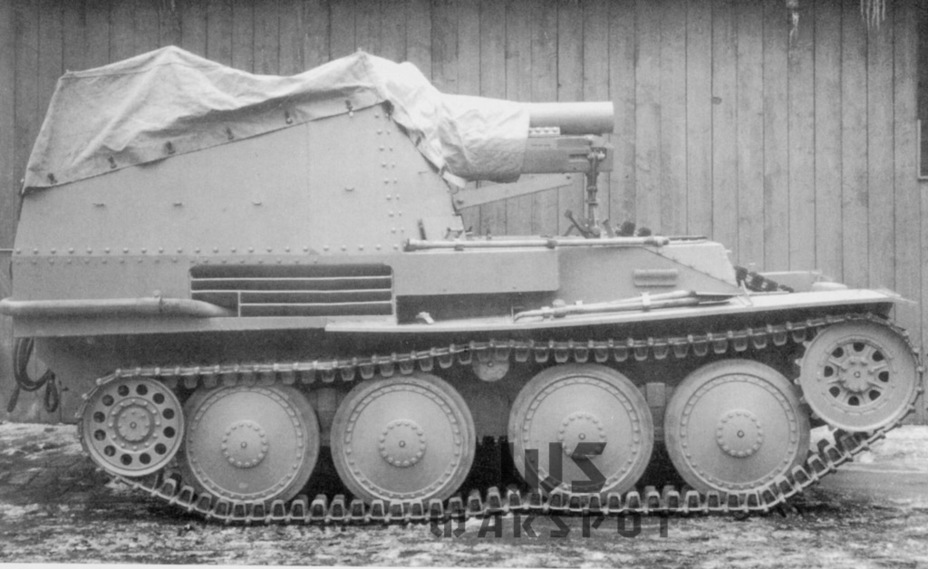
The primary purpose of the Motor vorn was not an assault gun, but a tank destroyer. BMM received the order for the chassis in February of 1943 and production of the 7.5 cm Pak 43/3 auf Sfl.38 (Ausf.M) Motor vorn began in May. An optimization of light SPGs followed. The Pz.Kpfw.II chassis was used to build the Wespe, the Pz.Kpfw.38(t) chassis went to the Marder III. At the same time, it became clear that production of the Grille had to resume. Even though the Wespe was better suited for fire support of tank and panzergrenadier units, the production facilities were a limiting factor. Only 40 Wespe and 10-15 ammunition carriers (which could be converted into the Wespe if necessary) were built monthly. Units armed with the Grille also took losses, which had to be replenished. As a result, a decision was made to build the Grille using the Motor vorn chassis. This variant was named GW 38 M (Geschützwagen 38 M).
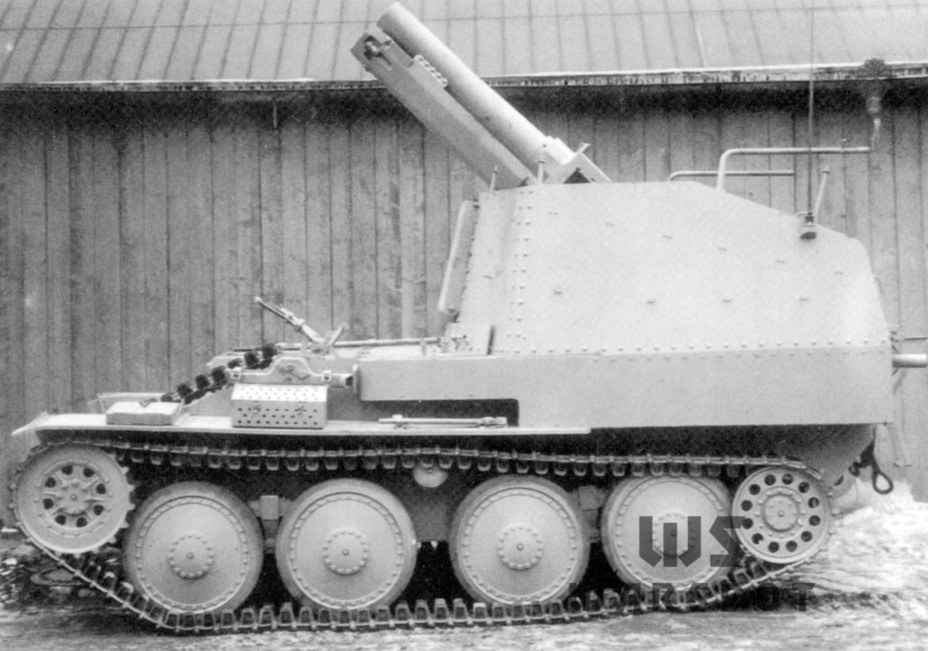
The chassis of the new SPG designated SF mit sIG 33 auf Fahrgestell Pz.Kpfw.38(t) (Motor Mitter) Ausf.K did not differ from that of the 7.5 cm Pak 43/3 auf Sfl.38 (Ausf.M) Motor vorn. Even the casemate was the same. The advantages and drawbacks of the layout were also the same. The gun, then the front of the casemate, and finally the engine deck had to be removed to service the engine and cooling system. A crane was needed for this operation.
The advantages made this complexity worth it. For one, the crew could now stand to full height without risking catching a bullet. There was now enough space for four crewmen. The ammunition capacity remained at 15 rounds, but they were better positioned. The rear plate could flip down and act as a ramp for loading ammunition, especially when firing from prepared positions. The gun was once again changed, now named 15 cm sIG 33/2. The alterations made it more compact and freed up even more space. The travel lock was also smaller now. The mass and mobility remained on par with its predecessor. The thickness of the armour decreased, but this was not critical.
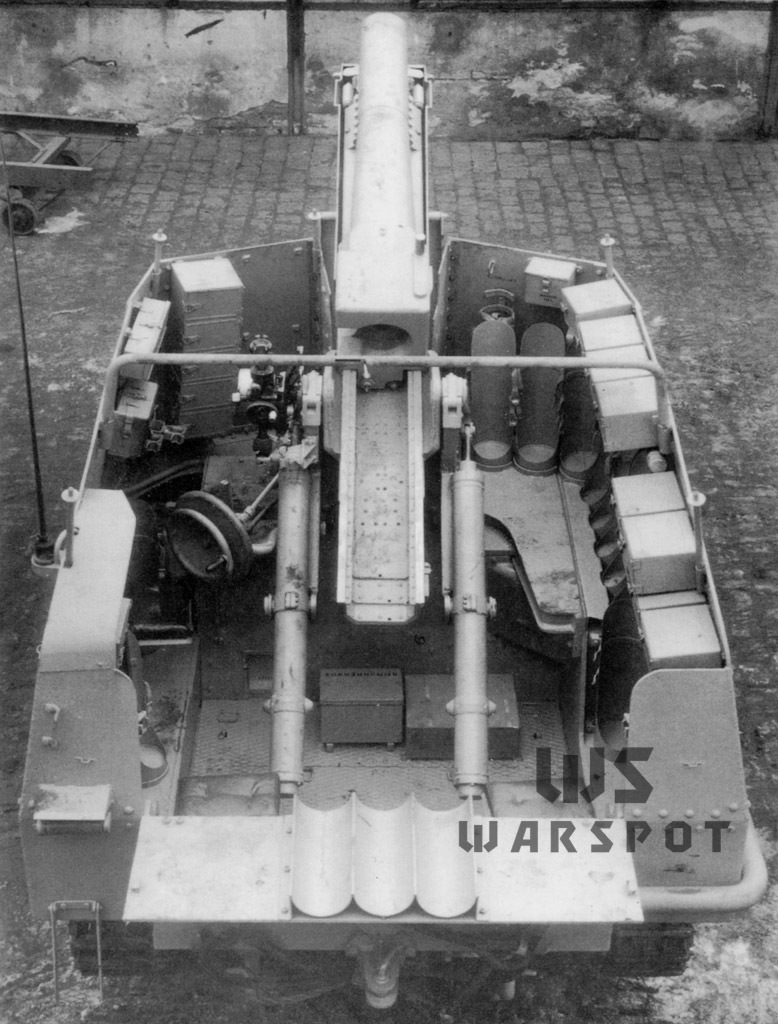
The vehicle went into production with the name Geschützwagen 38 M für sIG 33/2 (Sf.). The name Grille was also used to refer to it (the name Grille Ausf.M was never used). The chassis was changed by the time the vehicle went into production. BMM finally mastered welding of hulls in November of 1943. 14 SPGs were delivered during the first month of production, with the rates remaining low. 20 were delivered in January, 18 in February, 30 in March, 15 in April, 21 in May, 18 in June, 14 in July, 2 in August, 10 in September. This was because the Marder was still higher in priority. BMM also began building the Jagdpanzer 38 in March of 1944, which had a completely different chassis than the Grille. Because of this, production ceased in September of 1944.
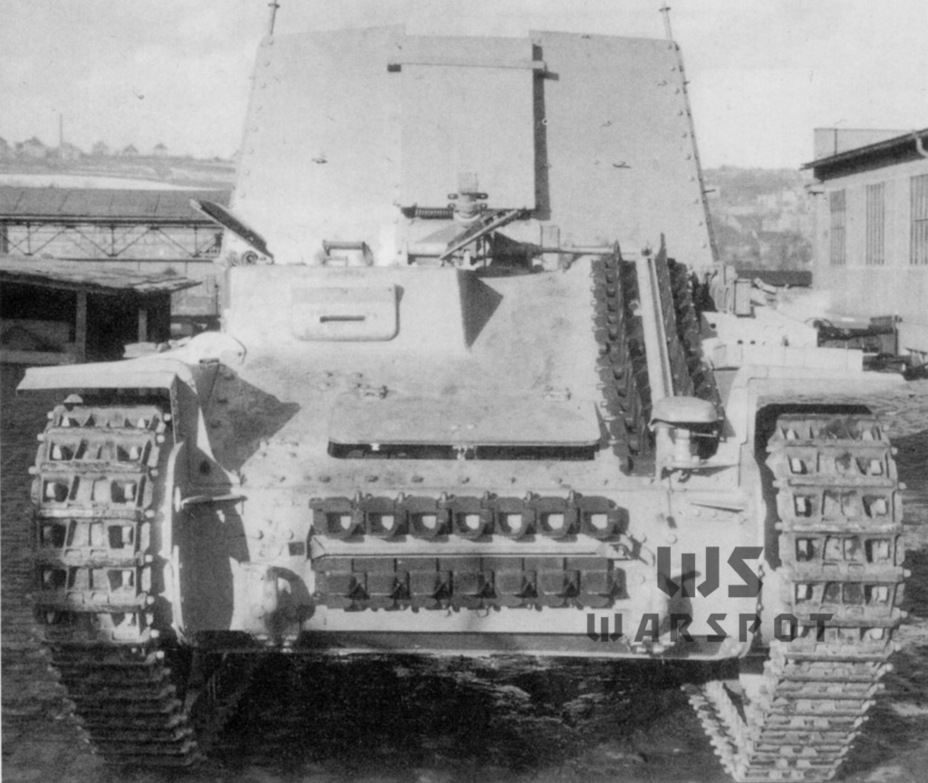
The Grille was one of the few vehicles whose production resumed after cancellation. 14 more were delivered in February of 1945 and 3 in March. BMM delivered a total of 179 vehicles. Their serial numbers ranged from 2851 to 3674. This huge range is explained by the fact that they shared the serial number pool with the Marder. The initial order was made for 200 vehicles of this type, but since the Jagdpanzer 38 was more important it was never fully filled.
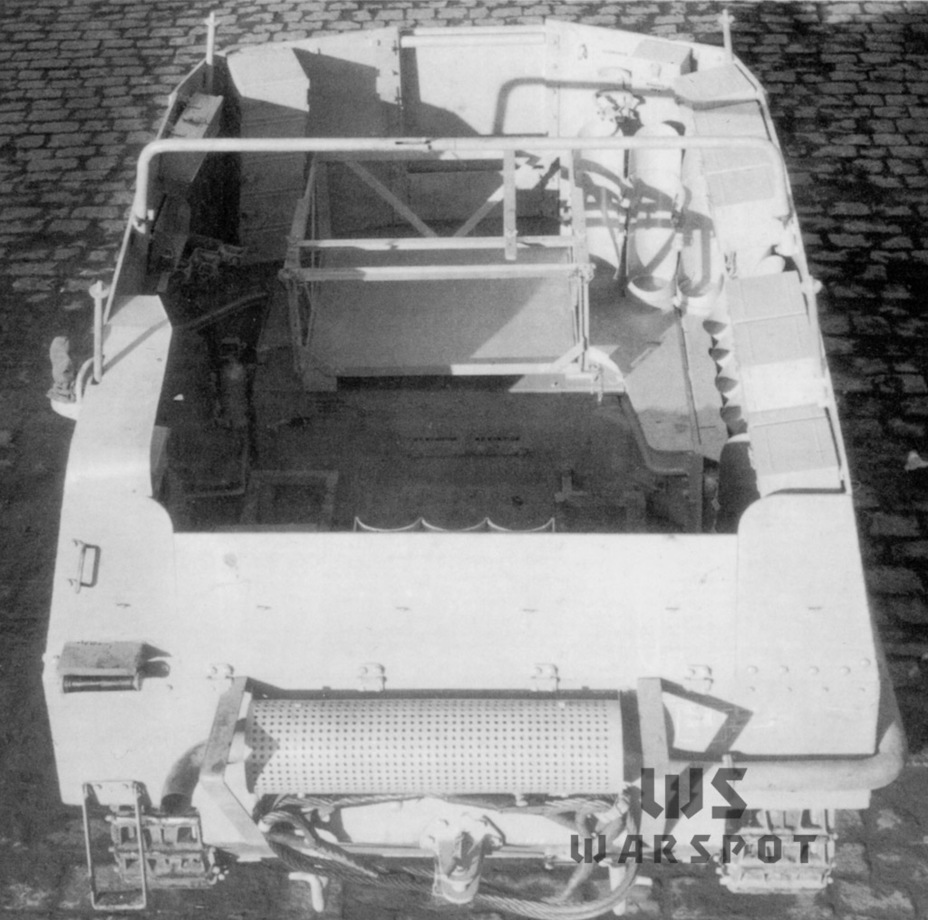
In addition to the Grille, the Munitionswagen (Sf) auf GW 38(t) was produced. This was effectively just a Grille with the gun removed. Like its counterpart on the Wespe chassis, it could be converted into a Grille if necessary. The first munitions carriers were delivered in January of 1944, 5 were built that month, 10 in February, 20 in March, 18 in April, 49 in May (102 in total). Their serial numbers were in the same range as those of the Grille.
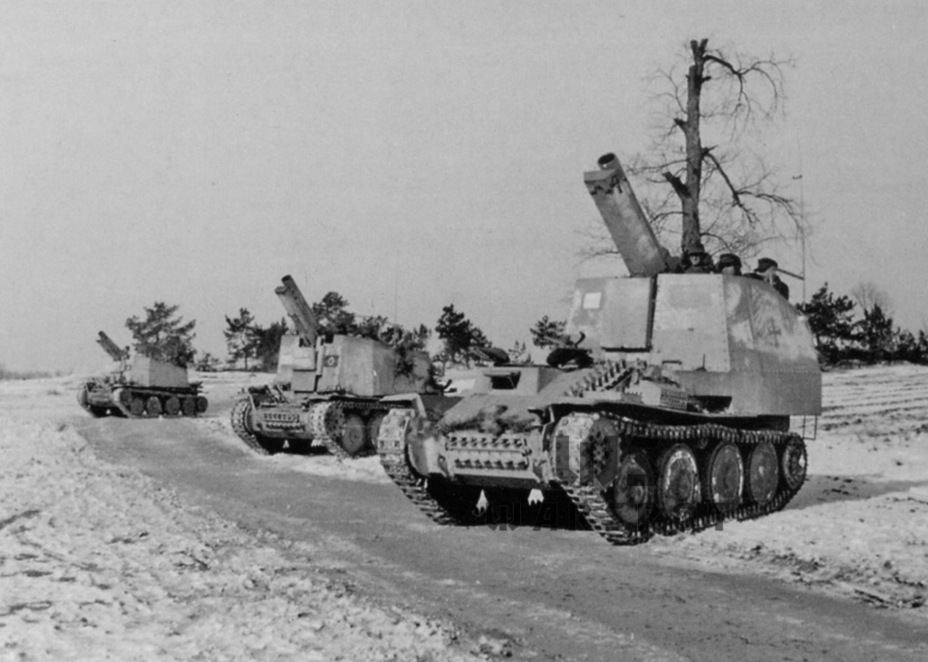
The new Grille were delivered starting in January of 1944. Strangely enough, the 1st Ski Brigade was among the first to receive them. The new Grille was usually issued in batteries of 6 each. However, only two units received them in January-February of 1944: the 1st Ski Brigade and the Panzer Lehr division. It later received two more Grille. 12 Grills were sent to the 2nd SS Tank Division in March of 1944. The remaining vehicles were parcelled out in batches of 1-4 to units that already used the Grille. Since technically the vehicles were very similar, it was considered acceptable to use mixed units.
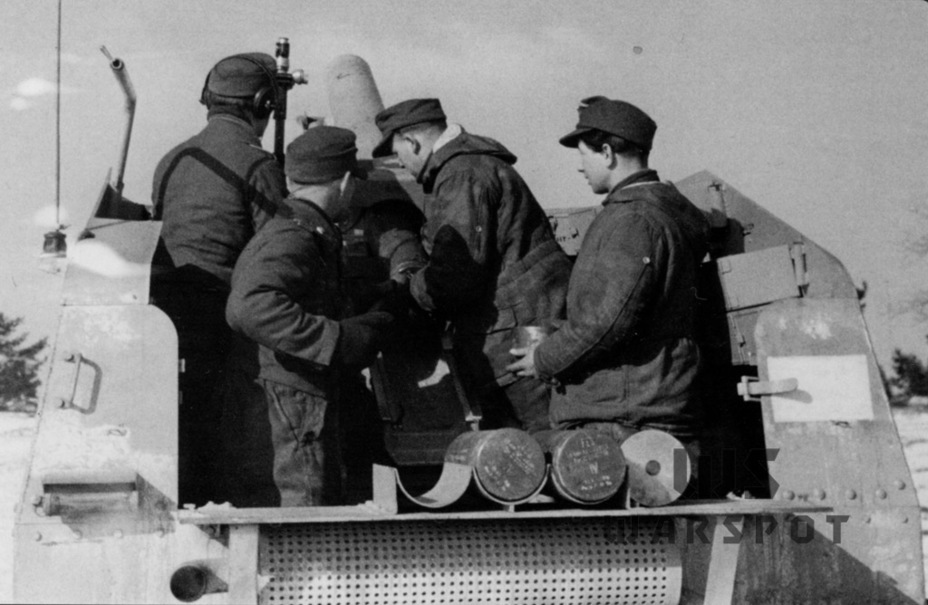
The new SPGs began arriving in whole batteries in May of 1944. Unlike the previous version, the Grille with a rear fighting compartment hardly ever went to Panzergrenadier divisions. They were sent to heavy batteries in tank divisions until almost the very end of the war. Due to the lull in production there were no reinforcements sent out in late 1944-early 1945, but 4 Grille were issued to the 16th Tank Division and 3 to the 19th Tank Division in February of 1945. The 20th and 8th Tank Divisions were some of the last units to receive the Grille. They were issued 6 each in March of 1945. 4 more were assigned to the 17th Tank Division on April 5th, 1945.
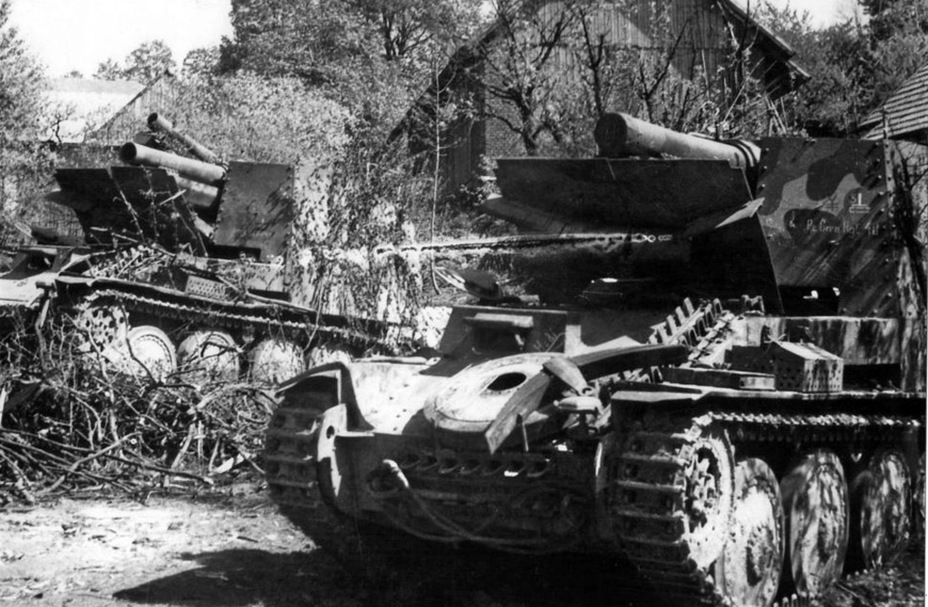
The combat performance of the Geschützwagen 38 M für sIG 33/2 (Sf.) differed little from its predecessor. The loader's work improved, since as mentioned above they could now stand to full height and had a more convenient rack to load from. This Grille was also better suited to fighting at close range, although this was risky for the crew, since it was easier to find and destroy it at close range. As for direct fire, this was a rarity. The weak armour and tall silhouette left it little chance of survival on the battlefield, especially since the ammunition was scattered all over the fighting compartment.
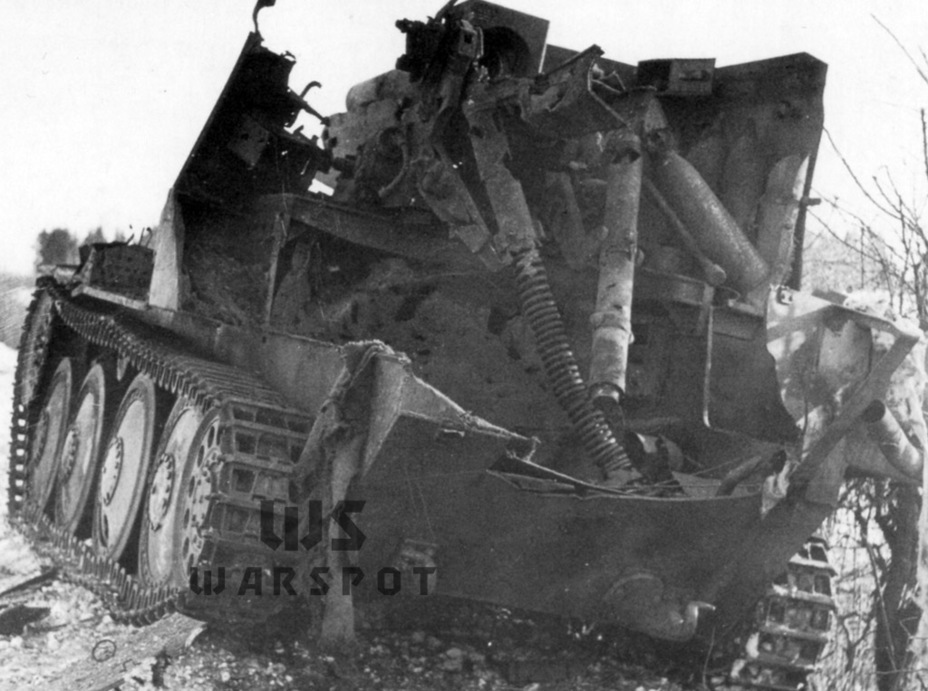
Even though there were 135 Grille of both types remaining in use by mid-March of 1945, few survive to this day. A single Geschützwagen 38 für sIG 33/1 (Sf.) was found on the bottom of the Enns river in Austria in 2000. The Geschützwagen 38 M für sIG 33/2 (Sf.) and the munitions carrier on its chassis were luckier. The Americans send home one of each. For a long time they were put on display at the Aberdeen Proving Grounds until they were restored and sent to Fort Sill in Oklahoma.
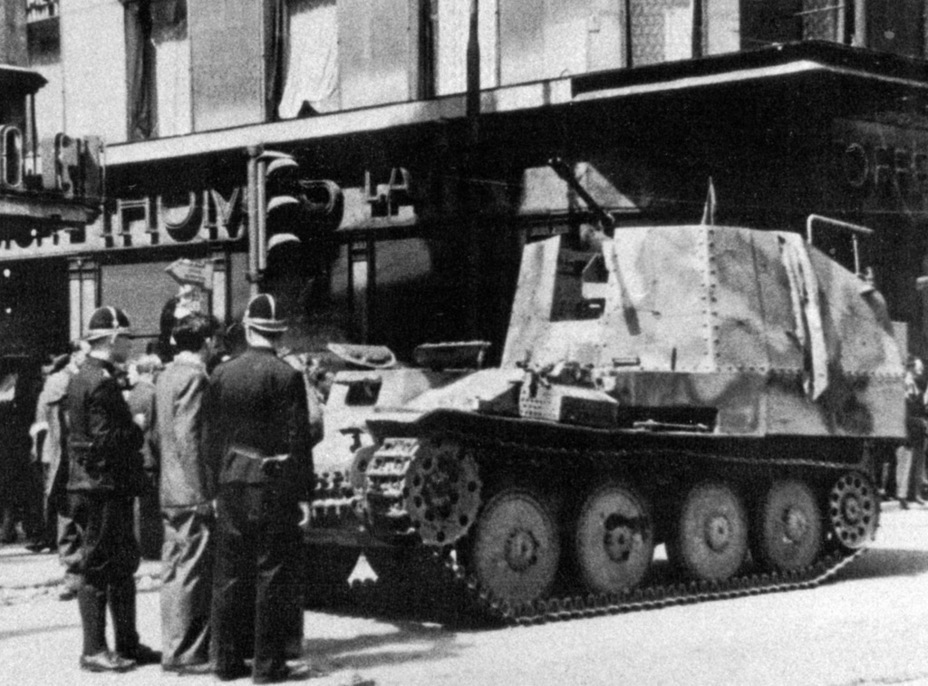
To conclude, one can call the Grille the best German light SPG armed with the 149 mm howitzer. It was comfortable for the crew and highly mobile. Unfortunately, the concept itself turned out to be poor. It was unsatisfactory as an assault gun due to its tall silhouette and thin armour. The range of its gun was too short for indirect fire. Unlike the Wespe and Hummel, which inspired spiritual successors in several nations, the Grille family did not continue.
Translated by Peter Samsonov. Read more interesting tank articles on his blog Tank Archives.
Sources:
- Central Archives of the Russian Ministry of Defence;
- Panzer Tracts No.10 Artillerie Selbstfahrlafetten, Thomas L. Jentz, Hilary L. Doyle, 2002, ISBN 0–9708407–5–6;
- Nuts & Bolts Vol.22: 15cm sIG33/2 (Sf) auf GW 38(t) Grille Sd.Kfz. 138/1 Part 1 Ausf. M, Heiner F. Duske, Tony Greenland, Detlev Terlisten, Nuts & Bolts, 2008;
- Nuts & Bolts Vol. 26: 15 cm s.I.G. 33/2 Grille Ausf H. Sd Kfz 138/1, Heiner F. Duske, Tony Greenland, Detlev Terlisten, Nuts & Bolts, 2010;
- Marder III & Grille, Vladimir Francev, Charles K. Kliment, MBI, 2001, ISBN 80-902238-8-5.






